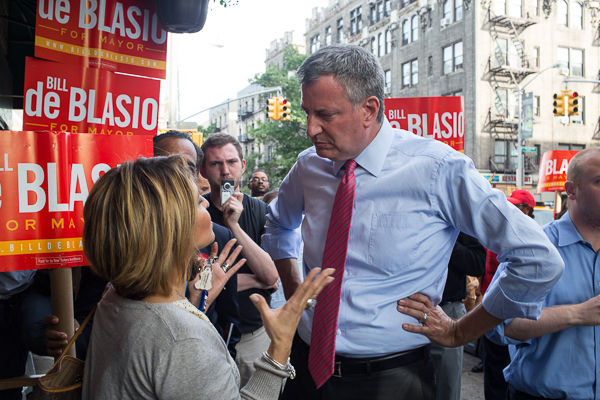
Photo by: Karla Ann Cote
According to the New York Post, violence is on the rise in the city, a federal judge’s ruling last month against the NYPD’s stop-and-frisk strategy is to blame and Democratic mayoral candidate Bill de Blasio—a leading critic of the strategy—has no solution to the crisis.
The Post reports today that “de Blasio insisted ‘nothing has changed in the approach to policing’ since Manhattan federal Judge Shira Scheindin’s Aug. 12 decision. ‘The judge’s order just happened and has not been implemented so obviously has not affected day-to-day policing,’ the Democrat said.”
But, the Post continued, “several police sources have said cops are reluctant to do more than the bare minimum because of the reforms ordered by the judge.” A day earlier, the paper had reported that “shootings were up 13 percent and gun seizures were down more than 17 percent in the 28-day period ending Sept. 8 as compared with the same period in 2012.”
It’s no surprise that Rupert Murdoch’s daily, which opined in its editorial endorsing Christine Quinn in the September 10 primary that “a de Blasio mayoralty would be an express train right back to the bad old days of the 1970s,” is swinging brickbats against the left-leaning nominee. And de Blasio may well have been caught flat-footed by the newspaper’s question; after all, he was busy yesterday picking on poor David Yassky.
But the Post‘s alarm over a surge of violence in the city sounds awfully familiar.
Last July, Post columnist Michael Goodwin wrote that Mayor Bloomberg “has been caught off guard by the sudden spike in city violence.” He warned that, “All the mayor’s beloved ‘edgy’ projects will turn to dust if the lead keeps flying and the bodies keep piling up.” “Suddenly, something dramatic and awful is happening on the streets and the mayor is behind the curve, and sounds as if he’s stuck in denial,” Goodwin wrote, noting a “28 percent increase in shootings last week, and nearly 10 percent for the year.”
Earlier last July, the Post‘s news section headlined a story “City shot to hell: Gun victims soar 46% for 1-week period.” The article read: “Cops blamed the bloodbath on rising temperatures and increased scrutiny on the controversial stop-and-frisk procedure that proponents say takes dangerous criminals off the street. ‘That is a major contributing factor,’ one law-enforcement source said of the decrease in stop-and-frisks. ‘[Street cops] are collectively afraid. It’s because of the political consequences and [Civilian Complaint Review Board] complaints.'” The article also cited a wave of police retirements and rising temperatures as possible causes.
The spike in shootings soon died out. Last year the city ended the year with an incredibly low 419 homicides—96 fewer killings than in 2011.
In July 2011, Post readers opened their paper to read a story slugged “SEEMS LIKE OLD CRIMES – GOTHAM FACING FIRST FELONY RISE IN 18 YRS” that reported, “Crime is on the verge of going up this year for the first time in nearly two decades.” Actually, crime was down (although “only slightly”), but there were spikes in half of the city’s 76 precincts. A month later, the Post noted that “Nine police precincts are showing an alarming spike in crime—and could lead the way to the first citywide increase in decades.”
By the end of the year, murders in 2011—surely not the only measure of violence, but probably the most important one—were down 4 percent from 2010.
Those of us who came to the city as crime was beginning to fall during the 1990s are probably a little spoiled: New York was a very different place—particularly its most victimized neighborhoods—when there were more than 2,000 slayings a year. It’s natural to worry about violence returning and wise to fear the complacency that safety breeds. And the peace most of us enjoy on our home blocks is less assured in several parts of the city.
But a cynic might wonder if the Post and others push the fear button again and again and again to, I don’t know, sell papers? Crazy idea, right?
Let’s return to the present day and a place called reality. The mayor’s office last week released figures showing that through September 8, New York City had seen 84 fewer murders and 225 fewer shootings than at this point in 2012—which, mind you, was a year when the city “saw the lowest number of murders and the lowest number of shootings at any time since comparable records were kept.” It’s unclear exactly how stop-and-frisk activity this year compares with last, but in the first quarter of 2013 the number of stops was down more than 50 percent from a year earlier.
Perhaps the Post is right, and de Blasio has no solution to the crisis. Or perhaps there isn’t a crisis to solve.
Correction: The original version of this article referred to “those of us who came to the city as crime was beginning to fall during the Giuliani years.” While I did come to the city during the Giuliani years (in 1994), it’s well documented that crime began to fall during the tenure of Mayor David Dinkins. The number of murders reached an all-time high of 2,262 during Dinkins’s first year in City Hall, then dropped the final three years he was in office, falling 13.7 percent by 1993. The drop did, however, accelerate under Mayor Giuliani; the number of murders fell 61 percent from Dinkins’s final year in office through the last year of Giuliani’s first term, 1997.







